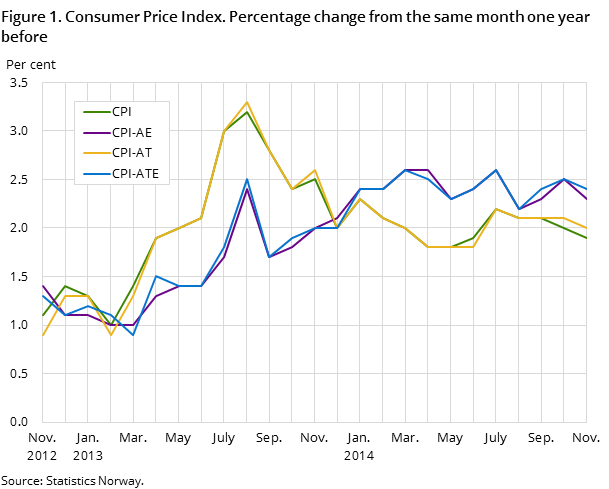Content
Published:
This is an archived release.
Small changes in the CPI
The Consumer Price Index (CPI) rose by 0.1 per cent from October to November, mainly due to higher prices of books and clothing. The year-to-year growth in the CPI was 1.9 per cent in November, while the CPI-ATE growth was 2.4 per cent in the same period.
| Monthly change (per cent) | 12-month rate (per cent) | Index | |
|---|---|---|---|
| October 2014 - November 2014 | November 2013 - November 2014 | November 2014 | |
| CPI All-item index | 0.1 | 1.9 | 137.9 |
| Food and non-alcoholic beverages | 0.2 | 2.5 | 129.9 |
| Housing, water, electricity, gas and other fuels | 0.2 | 1.1 | 169.5 |
| Transport | -0.7 | 2.9 | 149.2 |
| Recreation and culture | 0.3 | 2.4 | 120.5 |
| Clothing and footwear | 0.9 | -0.9 | 55.1 |
| CPI-ATE (july 1999 = 100) | 0.1 | 2.4 | 128.8 |
| CPI by delivery sector | |||
| Other consumer goods produced in Norway | 0.6 | 0.7 | 163.8 |
| Imported consumer goods | 0.0 | 1.2 | 91.8 |
| Other services with wages as dominating price factor | 0.2 | 3.7 | 211.9 |

The CPI was 137.9 (1998=100) in November 2014, compared to 135.3 in November 2013, which corresponds to a year-to-year growth of 1.9 per cent.
Monthly change: increased prices on books
The CPI increased 0.1 per cent from October to November, mainly due to higher book prices. These normally rise from October to November mainly due to the introduction of new titles. This year’s increase was 8.9 per cent. Prices of furniture and furnishing went up 1.9 per cent.
Clothing prices rose 1.0 per cent from October to November, while prices of food increased 0.2 per cent in the same period. Electricity prices also went up last month.
Airfares fell 9.3 per cent last month, and together with lower prices on household textiles was the most important factor in dampening the increase in the CPI. Lower prices on audio-visual equipment and products for routine household maintenance also contributed.
Year-to-year growth: higher rents and more expensive food
The CPI rose by 1.9 per cent from November 2013 to November 2014. Imputed rentals for home owners have had a falling growth rate in 2014, but with an increase of 2.2 per cent were still this month’s single most important factor in the year-to-year growth in the CPI. Food prices were 2.2 per cent higher in November this year than November last year.
The year-to-year growth in the CPI was mainly dampened by lower electricity prices. Prices of electricity including grid rent fell by 5.8 per cent in the last twelve months.
Change in the year-to-year growth: growth slowing down
The year-to-year growth in the CPI decreased from 2.0 per cent in October to 1.9 per cent in November. The main contributor to the fall was the price development of household textiles and furniture from October to November 2014 compared to the same period last year. On the other hand, prices of chocolate and hydroelectric power pulled in the opposite direction, with a price increase from October to November this year compared to a price fall in the same period last year. The year-to- year growth in the CPI-ATE was 2.4 per cent in November, down 0.1 percentage point from October.
Contact
-
Statistics Norway's Information Centre
E-mail: informasjon@ssb.no
tel.: (+47) 21 09 46 42
-
Konsumprisindeksen
E-mail: konsumprisindeksen@ssb.no
tel.: (+47) 62 88 56 34
-
Camilla Rochlenge
E-mail: camilla.rochlenge@ssb.no
tel.: (+47) 40 90 23 72
-
Kjersti Nyborg Hov
E-mail: kjersti.nyborg.hov@ssb.no
tel.: (+47) 40 90 23 63
-
Gunnar Larsson
E-mail: gunnar.larsson@ssb.no
tel.: (+47) 40 90 26 79
-
Trym Kristian Økland
E-mail: trym.okland@ssb.no
tel.: (+47) 46 81 09 15
